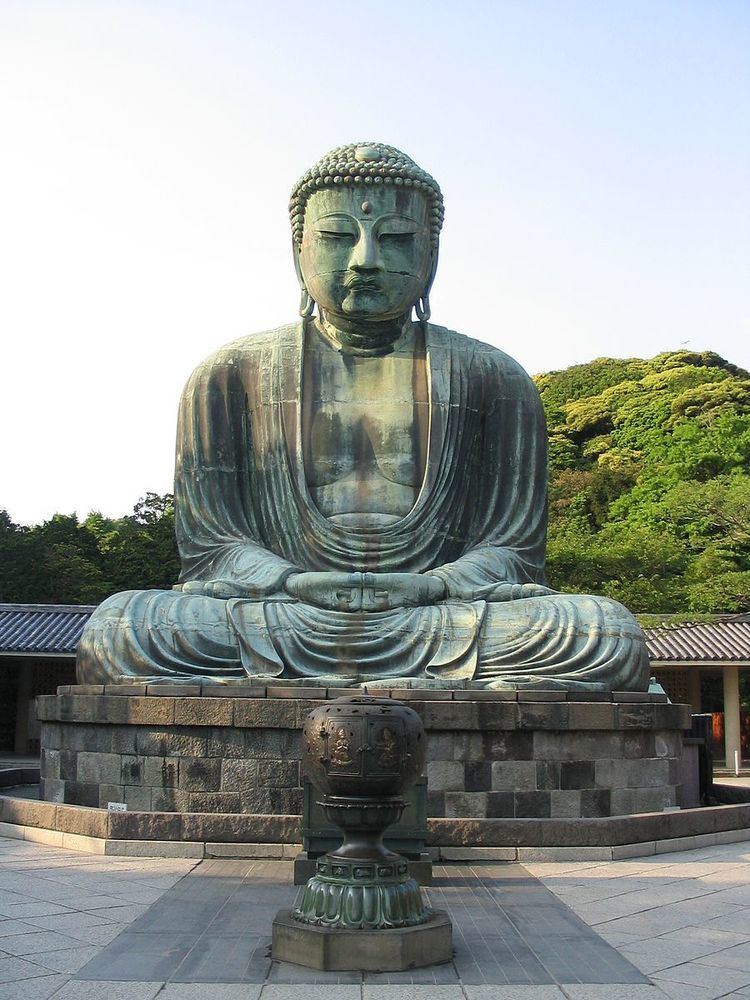Phone +81 467-22-0703 | ||
 | ||
Similar Hase‑dera, Tsurugaoka Hachimangū, Hase Station, Kenchō‑ji, Kamakura Station | ||
Kōtoku-in (高徳院) is a Buddhist temple of the Jōdo-shū sect in the city of Kamakura in Kanagawa Prefecture, Japan.
Contents
The temple is renowned for its "Great Buddha" (大仏, Daibutsu), a monumental outdoor bronze statue of Amida Buddha which is one of the most famous icons of Japan.
The Great Buddha
The Great Buddha of Kamakura is a monumental outdoor bronze statue of Amitābha Buddha located at the Kōtoku-in Temple in Kamakura, Kanagawa Prefecture, Japan. The bronze statue probably dates from 1252, in the Kamakura period, according to temple records. It was preceded by a giant wooden Buddha, which was completed in 1243 after ten years of continuous labor, the funds having been raised by Lady Inada (Inada-no-Tsubone) and the Buddhist priest Jōkō of Tōtōmi. That wooden statue was damaged by a storm in 1248, and the hall containing it was destroyed, so Jōkō suggested making another statue of bronze, and the huge amount of money necessary for this and for a new hall was raised for the project. The bronze image was probably cast by Ōno Gorōemon or Tanji Hisatomo, both leading casters of the time. At one time, the statue was gilded. There are still traces of gold leaf near the statue's ears.
The hall was destroyed by a storm in 1334, was rebuilt, and was damaged by yet another storm in 1369, and was rebuilt yet again. The last building housing the statue was washed away in the tsunami of September 20, 1498, during the Muromachi period. Since then, the Great Buddha has stood in the open air.
The statue is approximately 13.35 metres (43.8 ft) tall including the base and weighs approximately 93 tonnes. The statue is hollow, and visitors can view the interior. Many visitors over the years have left graffiti on the inside of the statue. At one time, there were thirty-two bronze lotus petals at the base of the statue, but only four remain, and they are no longer in place. A notice at the entrance to the grounds reads, "Stranger, whosoever thou art and whatsoever be thy creed, when thou interest this sanctuary remember thou treadiest upon ground hallowed by the worship of ages. This is the Temple of Buddha (sic) and the gate of the eternal, and should therefore be entered with reverence."
The Great Kanto Earthquake of 1923 destroyed the base the statue sits upon, but the base was repaired in 1925. Repairs to the statue were carried out in 1960–61, when the neck was strengthened and measures were taken to protect it from earthquakes.
In early 2016, further research, restoration and preservation work was performed on the statue.
Details
Poem by Rudyard Kipling
The statue is referred to as "The Buddha at Kamakura" in several verses that preface the initial chapters of the novel Kim by Rudyard Kipling (1901). The verses were taken from the poem of the same name the author wrote after visiting Kamakura in 1892. The poem appears in its entirety in "The Five Nations" of 1903.
